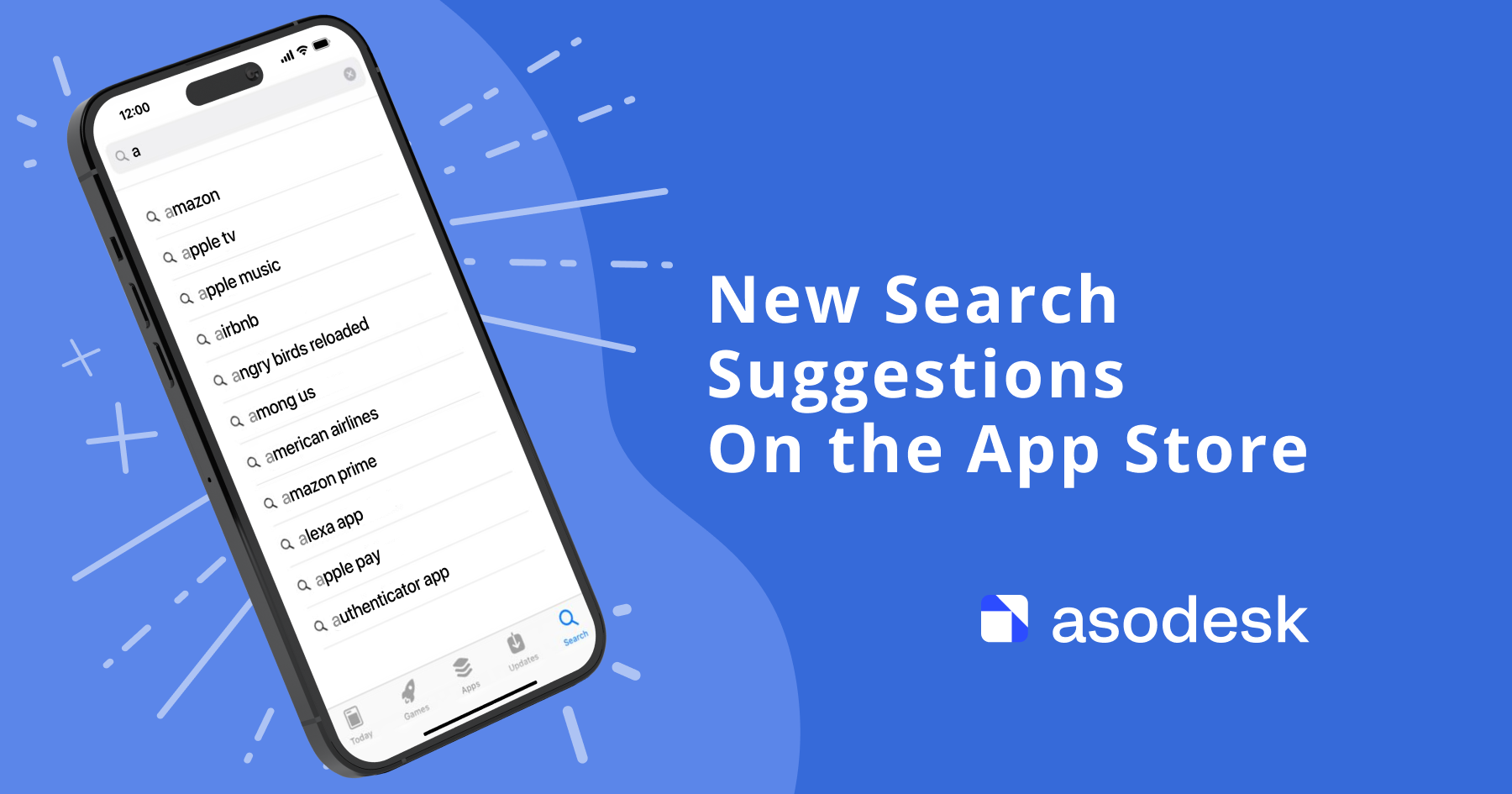Do in-app purchases affect ASO for App Store?
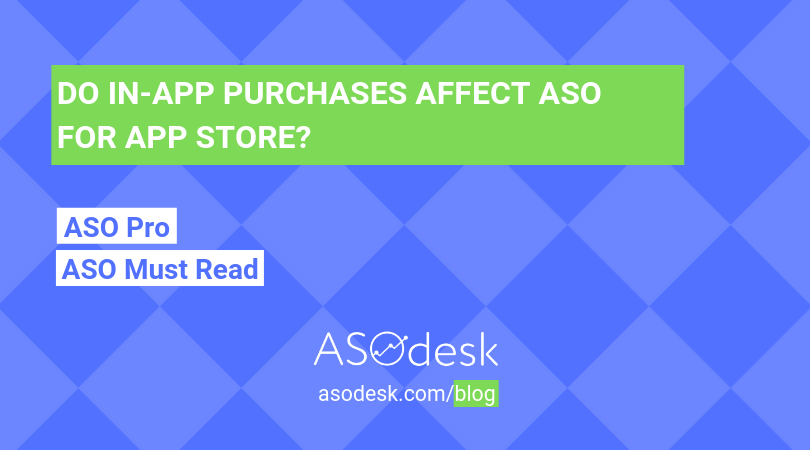
Competition between App Store applications is immense — using standard methods of work with metadata is not enough anymore, when it comes to acquiring the necessary number of users. It is necessary to work with visual components of the page, with localizations and user reviews, and to look for new, unobvious ways of drawing users to the application page.
Apple is constantly adding new functions that can be used for content promotion on the App Store. For example, during the launch of applications for iMessage, publishers that use integration with the messenger were featured on the store’s main page. In the same time, iMessage stickers were only additionally supported in the store itself and the company’s social channels. It’s necessary to remember that Apple always gives preference to developers that use newest features of the operational system. This is why it is important to analyze all the App Store novelties and understand how they could be used for marketing purposes.
Right now Apple is clearly interested in promoting a model of subscription monetization. There is a separate “Our Favorite Subscriptions” section on the main screen in the application category on the US App Store.

Also, you might have noticed that search queries on the App Store allow not only finding the apps themselves, but as well stickers for iMessage, in-app purchases, and subscriptions. In-app content has long been available for App Store promotion outside from their applications. We decided to check how would application’s and in-app purchases’ metadata affect each other and what is provided in the search listings for them.
In-App Purchases
Starting with iOS 11 it is now possible to promote and offer in-app purchases right on the App Store and not just only within the application. Updated store features a separate block for purchases and subscriptions.
Right now, developers can advertise up to 20 purchases within the app simultaneously on their product page in Subscriptions and In-App Purchases sections. In other words, users can look through in-app purchases of an application right on the App Store.
Starting with 2018 Apple continued developing its subscription model trend. Developers now gained an opportunity to publish trial subscriptions. This can be done in two formats: when an application works by a subscription model, a publisher can provide its users with a free month, so they can try out all of the app’s functions; also, one can provide a free in-app purchase (IAP) that will unlock all the paid functions for a limited period.
Adding In-App Purchases onto the Application Page
There are certain publishing rules for in-app purchases and subscriptions that can be promoted on the App Store. You need to create a separate icon and fill in textual metadata, such as title and description.

Each promoted in-app purchase requires its own advertising button that will provide its contents the best way possible. Advertising images shouldn’t be screenshots and shouldn’t repeat application’s icon in order to not confuse the users.
When an in-app purchase appears on App Store search results, the app’s icon is added to the lower left corner. Before uploading visual elements, it’s necessary to make certain that the icon’s design isn’t covered by the frame and, as well, remember to not add any important details in the lower left corner.
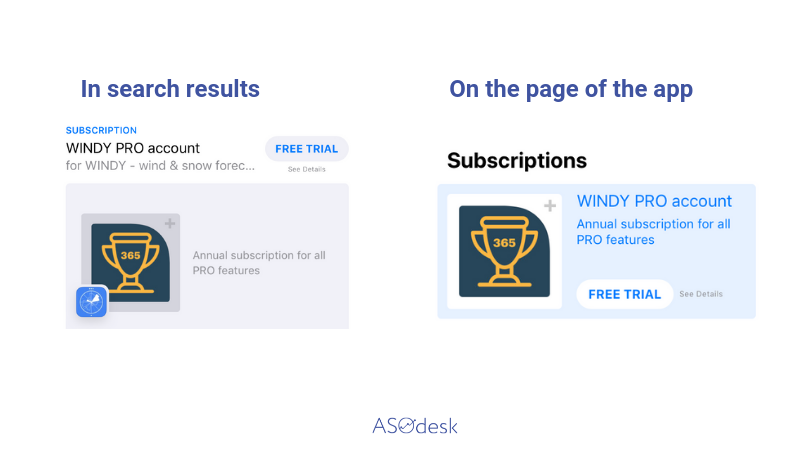
Purchase names within the application have to be clear and understandable for App Store buyers. Apple recommends avoiding such vague names, as “100 precious stones.” The name should reflect the essence of the purchase. For automatically renewable subscriptions you should outline in-app purchase action period. Displayed purchase names can be up to 30 characters long.
Description should be clear and draw attention and, thus, should include the description of advantages and functions that the user would get upon purchase. This description should be up to 45 characters.

How Are Subscriptions and In-App Purchases Displayed on the App Store
Subscriptions and in-app purchases can be found through the search, as well as applications themselves. They are displayed in the listing. Note that the search results will only display non-renewable purchases.
We noticed that in-app purchases are displayed in the list by the precise name of the in-app purchase or a part of its name, as well as by its name query. Subscriptions are displayed by a key phrase from the application title or from the subtitle and title.

If the user finds subscription through the search and then proceeds to the application page via it, the information is then displayed right below the icon.
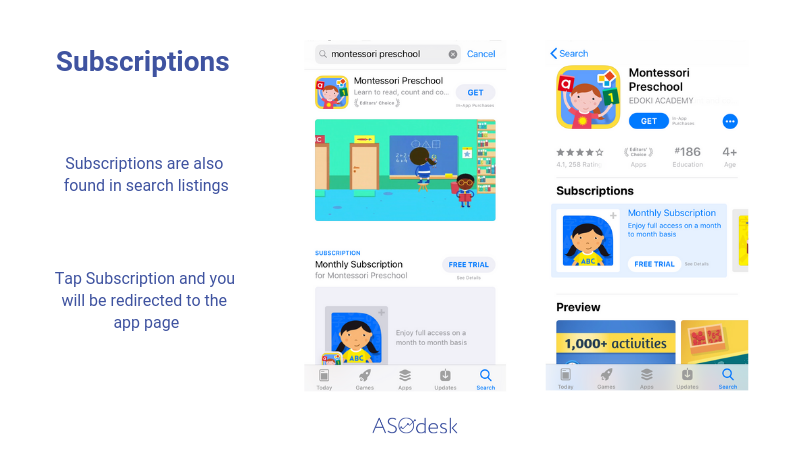
In-app purchases can be displayed in the listing separately, without the application as such, from the search, or under the application itself. The information about in-app purchases on the product page will look the same way subscription does.

In case the user finds the application itself and goes to the page from the search, the subscription or the in-app purchase is most often displayed in the lower part, under the “What’s new” section, or in “In-App Purchases” or “Subscriptions” sections.
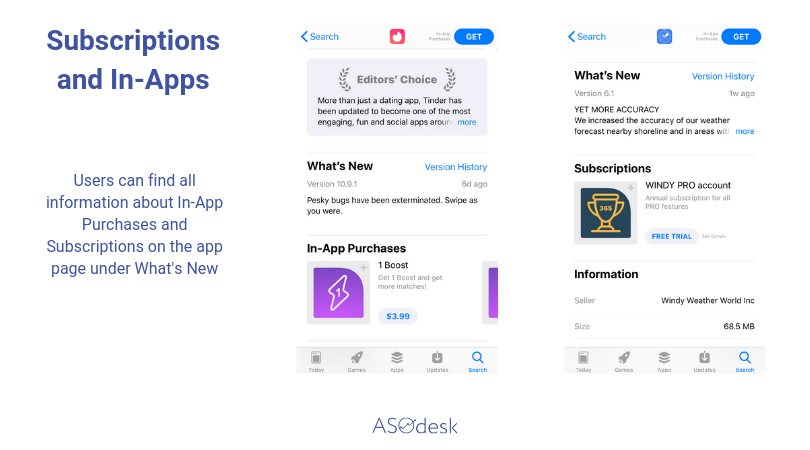
While testing this hypothesis on the US App Store, we discovered that the keyword search display mechanism doesn’t work with all purchases and subscriptions the same way. Sometimes, the in-app purchase is displayed right below the icon, even if you go straight to the application page from the search results. We have encountered such exceptions only a few times.
Analyzing Metadata
In order to understand, which keywords affect the listing of inside content in the search and whether in-app purchases’ metadata affects application display in the search, we decided to analyze application’s and its in-app purchases textual metadata.
For the experiment, we took the Scan to PDF+OCR — Fine Scanner and the PDF Scanner in-app purchase. Having used the ASOdesk Organic Report tool, we reviewed the list of queries, by which the application is searched for on the App Store and all the textual met data (title, subtitle, and keywords) that we have been provided by the developer.
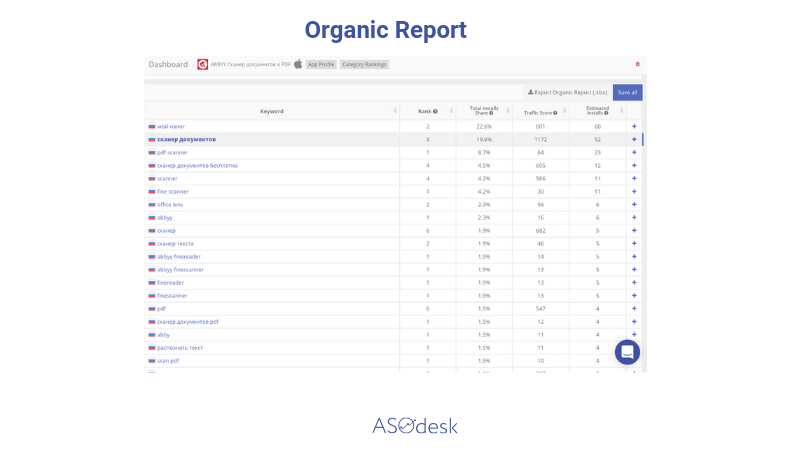
We discovered several interesting interconnections:
Application’s metadata directly affects the display of in-app purchases and subscriptions on the App Store search.
According to the report, the PDF Scanner subscription for the Scan to PDF+OCR — Fine Scanner application can be found by separate keyword searches from the title and subtitle. Moreover, these queries have search settings. The report showed that the subscription isn’t displayed by particular keyword searches and their combinations from the keyword field.
Also, we have manually tested the US App Store search: 50 different applications from various categories with subscriptions. Of course, this is not a large selection that would be able to provide us with a 100% confidence about this interconnection, but, according to our observations, subscription by queries from the title is always displayed in the listing right below the application itself. It can also be displayed by the name of the subscription itself.
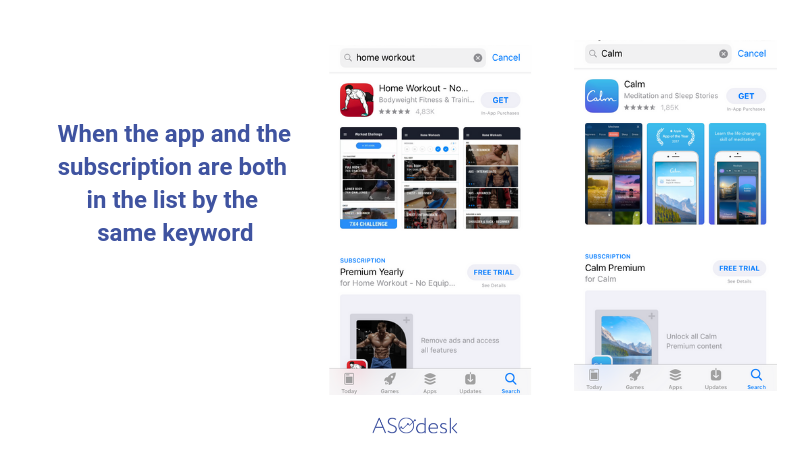
However, there could be exceptions — in one country, subscriptions can be displayed under the app by search queries in the search listing, while in another country they can’t.
Subscription display by queries from title and subtitle in Russia.

If we use the same queries from the title and subtitle in the USA, the subscription isn’t displayed.

It’s not entirely clear what affects it — promotion of a particular search query in a particular country or the amount of downloads of an in-app.
What conclusions can we make out of this small research on in-app purchases and subscriptions?
From the ASO point of view, we see several interesting facts here:
- Display of in-app purchases in search results can provide more links for passing to the app page, and more opportunities for app installs directly from search listing.
- When an application and subscription or in-app purchase are displayed in the top search results by a well-promoted short-tail keyword, they take two or three spots in the search listing depending on the number of promoted purchases. Henceforth, the listing leaves no place for competitors that use the same keywords.
When an application and subscription or in-app purchase are displayed in the top search results by a well-promoted short-tail keyword, they take 2 or three spots in the search listing depending on the number of promoted purchases. Henceforth, the listing leaves no place for competitors that use the same keywords.
If your application is using a subscription model or in-app purchases, you should take advantage of promoting them on the App Store. This will provide you with additional spots in the search listing and you will be able to tell about your application’s paid opportunities before its install.
Also, don’t forget about Apple’s “Favorite subscriptions” compilation on the store’s main page — getting into it will provide you with more visibility.
If there is anything you would like to add to this material, leave your comment below. We are always glad to get your feedback!

